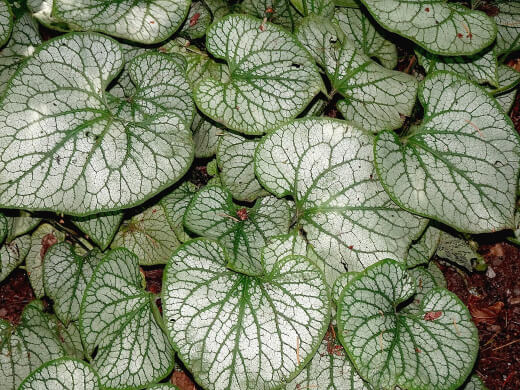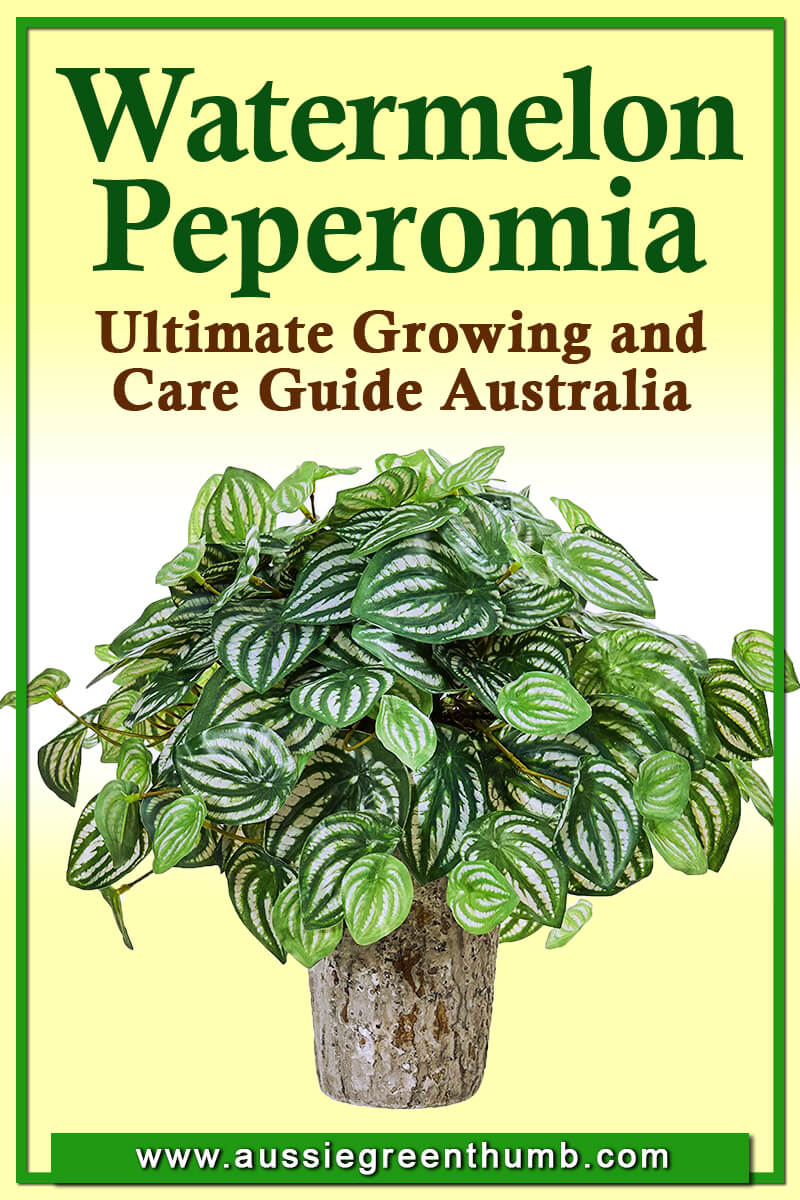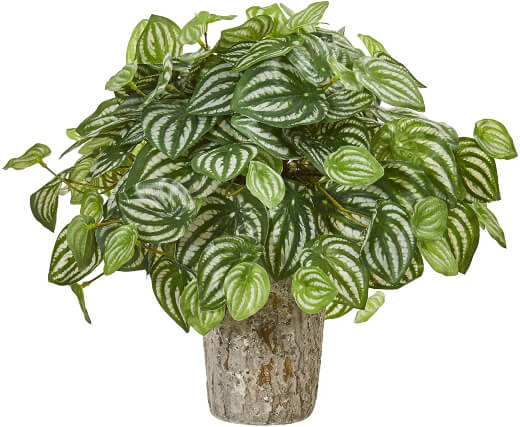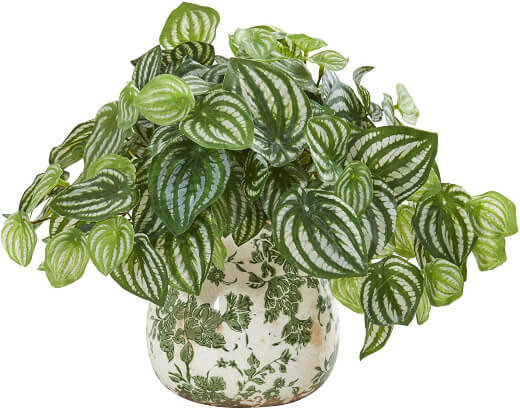Watermelon peperomia (Peperomia argyreia) is a tropical plant originating from South American. It gets its common name from attractively green leaves that are striped and shaped like watermelon.
These plants are low-growing, often only reaching 30cm in height, with dwarf varieties reaching about 15 cm. Although they do develop small flower spikes, these are pretty insignificant, and the main attraction are the attractive, lush leaves.
More...
They grow very easily indoors and require little in the way of maintenance, and if you live in a tropical area of Australia, they’ll grow well in shaded spots outdoors if planted in your garden, in hanging baskets or in containers. They’re non-toxic to pets too.
Simple to care for, these plants are great for beginners or anyone who wants a tropical plant that isn’t too demanding. All they need is enough indirect sunlight, protection from cold weather and moist, well-drained soil.
Creating the Right Environment to Grow Watermelon Peperomia

For any plant to thrive, they need the right climate and environment. For the watermelon peperomia care, you need to consider the following:
- Temperature – As a tropical plant, Peperomia argyreia likes warm conditions. The do best in temperatures no lower than 10°C and no higher than 27°C, and will not tolerate frost.
If it gets too cold, you will see the leaves start to drop. You can protect container plants by moving them under shelter in very hot or very cold weather. - Sunlight – In their natural environment, these plants grow in dappled shade, forming a thick cover of undergrowth beneath jungle trees.
Direct sunlight will burn the leaves and even too much bright indirect light can cause the lines in the leaves to fade.
The best spot for your plant will be a bright space out of the sunshine, either indoors or outside under the cover of a patio roof or heavy tree growth. - Well-Draining Soil – Tropical plants like moisture but quickly die if they get waterlogged, so it’s best to use a peat-based soil mix of two parts peat to one part perlite.
- Water – It’s easy to overwater these plants and kill them, so remember that less is more. Only water when the top 2cm of soil is dry to the touch, and then water it to soak the soil thoroughly.
Let the excess drain away and make sure the roots of the plant aren’t sitting in water (this is especially important if you have the plant pot sitting in a decorative pot that has no drainage holes).
You will have to increase watering in hot weather if the leaves start to droop and the soil is dry – just remember to water less frequently when the weather cools down. - Fertiliser – These plants are not high-nutrient users and grow well on a slow-release all-purpose fertiliser or mulch (for outdoor plants). Apply the fertiliser every 2-4 weeks in spring and summer and only once a month in winter.
For potted plants, you can avoid over-fertilizing your plant by applying a much weaker solution of liquid fertiliser – about 1/2 to 1/3 the manufacturer’s recommended strength.
If your watermelon peperomia becomes spindly and leggy, it is probably being overfed. Repot it or propagate a new plant and reduce feeding significantly to get full, lush growth.
How to Avoid Overwatering Your Watermelon Peperomia
It’s easy to overwater indoor plants, especially tropical ones, and it’s one of the most common reasons for these plants to die. Your watermelon peperomia is being overwatered if it is showing the following symptoms:
- Wilting leave
- Raised, scab-like protrusions on the leaves
- Brown, mushy roots and a rotting smell
If you notice these signs, the first thing to do is stop watering your plant. If it hasn’t been going on for too long, the plant should recover after the soil dries out.
You can also repot your plant in a dry mix of perlite and peat soil, or try propagating a new plant from a leaf or stem that is in good condition. Only water your plant when the top 2cm of soil is dry to the touch.
Increase Humidity By Misting Your Peperomia
If the weather is very dry, you can help create a more tropical environment for your Peperomia argyreia by misting the leaves (not the roots or soil) with water from a clean spray bottle.
You can also place it in the room with a humidifier or create a humidity tray for the pot to sit on, by filling a tray with pebbles and water. Place the plant container on top of the pebbles, not in the water.
How to Propagate Watermelon Peperomia
Propagating watermelon peperomia is very simple using either of two methods below:
- Leaf propagation – This method is the most recommended way to propagate a watermelon peperomia. All you have to do is cut a leaf in half (stem to tip), press it gently into a mix of well-draining soil, and wait a couple of weeks to a month for the new roots to appear.
You can use rooting hormone to make this process a bit faster. - Stem propagation – Find a healthy stem on your plant and cut it off using sharp secateurs, placing the tip of the stem in a container of clean water, out of direct sunlight.
The roots will start to appear in a few weeks, and you can then gently plant it into your potting mix.
How to Repot a Watermelon Peperomia
These plants grow pretty slowly, so you only need to repot them every few years. You can tell if your plant needs repotting you’ve owned if for 3 years or more and it’s still in its original container, and small roots are pushing up out of the surface of the soil
First, choose a new pot for your plant that’s only a couple of centimetres bigger in size, as these plants like cramped living conditions. Make sure the pot has drainage holes, as this will help prevent overwatering.


Get Your Free Guide:
Master Growing Australian Natives eBook
A Must Have Complete Guide for Every Australian Garden
Get Your Free Guide:
Master Growing Australian Natives eBook
A Must Have Complete Guide for Every Australian Garden
The best soil for these plants is something that drains water quickly, and we recommend a two parts peat to one part perlite mix.
Cover the bottom of the pot in a layer of soil, place your plant in gently, taking care not to damage the roots, and cover with soil until the pot is full, without covering the stems. Water thoroughly and leave to drain.
Dealing with Diseases and Pests
One of the best things about watermelon peperomia is how resistant they are to disease and pests! If you keep them warm, fed and watered with enough light, the plant will be strong enough to resist most diseases and pests.
If your plant is stressed or unhealthy, it can fall victim to the following issues:
- Root rot – Root rot strikes if your plant is being overwatered, causing the leaves to yellow and die and the roots to turn brown and mushy, and the leaves will wilt and die.
Plants with minor root rot can be repotted to save them, but in most cases, it is better to try propagating a new plant from a healthy leaf or stem. - Whiteflies, spider mite and mealybugs – Start by isolating your plant by moving it far away from your other houseplants. Spray with a recommended insecticide, natural insecticide or neem oil, and manually remove insects where you can.
- Fungus gnats – These are harmless tiny black flies that you may see on the soil of your houseplant. Fungus gnats are an annoyance more than anything else and commonly arrive in potting soil or be transmitted from other plants in the nursery.
They can be easily treated with a general insecticide or natural insecticide. Refer to our in-depth guide on how to get rid of fungus gnats and find out different ways on how to do it.

Watermelon Peperomia Frequently Asked Questions
Is watermelon peperomia easy to care for?
Watermelon peperomia is easy to care for and simple to grow indoors. Their stunning striped leaves do need regular watering, but like all Peperomia, wilted leaves can be quickly revived by dampening dry soil (you can literally see the recovery in front of your eyes in real time).
Does watermelon peperomia need sunlight?
Watermelon peperomia needs bright light, but never direct sun. Peperomia have broad leaves that store water, so leaving them exposed to bright afternoon light can dry them out too quickly.
Aim for medium to bright light where possible, either on a table away from the window, or in an east-facing window.
Should I mist my watermelon peperomia?
Watermelon peperomia benefits from misting, but that will need to be balanced with good temperatures too. Misting while cool can cause fungal problems. Misting during warm afternoons can cause leaf scorch.
Misting when it’s about 18-22°C should be just right to maintain humidity and prevent moisture loss from the leaves.
Do you water watermelon peperomia from the top or bottom?
Water watermelon peperomia thoroughly and reasonably frequently, but let the soil dry out before watering again. Because Peperomia likes to be watered really well, rather than little and often, it’s best to water them from the base by standing them in water.
This way, the soil can soak up everything it needs. Then just let it drain and place it back in its container.
How do you get watermelon peperomia bushy?
To create a more bushy plant, move your leggy watermelon peperomia to a brighter location. Avoid full sun, or direct afternoon light, and prune out any particularly leggy stems to encourage regrowth and lateral shoots.
What is the best soil for watermelon peperomia?
Despite being water-loving plants, watermelon peperomia needs good drainage. A soil mix with coir compost or orchid bark mixed through helps to retain moisture without acting as a sponge, and adding some perlite or sandy soil to the mix will aid drainage without making the soil completely arid.
Does watermelon peperomia grow fast?
Watermelon peperomia is a fast-growing houseplant that can be grown equally well outdoors in most of Australia. While they are not large plants, they can grow a few inches each year, and will eventually form a compact but dense dome.
Can I water watermelon peperomia with tap water?
You can water watermelon peperomia with tap water. While all plants prefer rainwater to tap water, Peperomia is not picky about its water and can cope with water straight from the tap if you don’t have time to leave it to air off or filter it.
What does an overwatered watermelon peperomia look like?
Overwatered watermelon peperomias show early signs of trouble with pale, fading foliage. If the leaves begin to turn yellow, stop watering and make sure there is no standing water around the base of the container.
Move your Peperomia somewhere bright and warm for a few days to dry out.
Why are the leaves falling off my watermelon peperomia?
If you have overwatered your watermelon peperomia, or the drainage holes have become blocked, the waterlogged soil can cause nutrients to be inaccessible, and the roots will fail to pass them to the leaves, causing fairly rapid defoliation.
Treat it as overwatering and attempt to dry out the soil with warmer temperatures, brighter light, and ventilation.
How long can watermelon peperomia go without water?
Watermelon peperomia can last for several weeks without water but should be watered once a week. If you forget to water your Peperomia on schedule, you’ll quickly notice its leaves dropping and fading. This will quickly resolve with a fresh drink.
Is watermelon peperomia a succulent?
Watermelon peperomia has succulent leaves with a glossy waxy coating and stunning stripes. Like most plants with succulent leaves, they are good at storing water to cope with drought, but will also suffer if they go for long periods with no water at all.
Enjoy Growing Your Watermelon Peperomia
With basic care and attention, your Peperomia argyreia will give you many years of lush, tropical vegetation in your home or out in your garden.
This low-maintenance South American plant will thrive with thorough watering (without letting it sit in water), indirect sunlight and light feeding through the spring and summer.
If you enjoy having peperomias around learn how to grow Peperomia ‘Hope’ and Peperomia obtusifolia as well. For more plant options you can grow both indoor and outdoor, check out our Monstera deliciosa and Elephant Ears growing guides.
We hope you enjoyed our guide and that it answers all your questions about growing and caring for watermelon peperomias!
Published on January 15, 2023 by Gary Clarke
Last Updated on February 25, 2024





